數據可視化 信息可視化
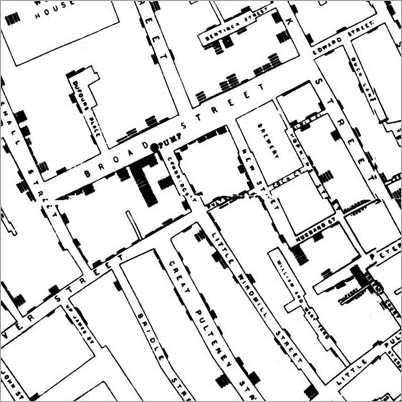
John Snow, “the father of epidemiology,” is famous for his cholera maps. These maps represent so many of our aspirations as data-designers. By obsessively (heroically!) diving into London’s 1854 cholera outbreak, laboriously gathering an infection dataset (at his own peril!), then overlaying the data around the infamous pump on Broad Street, John Snow not only revealed a fundamental truth about London’s cholera outbreak, but he also made it inescapably obvious to stubborn public officials. John Snow and his visualization saved a city — or so the legend goes (src, src).
約翰·斯諾 ( John Snow )是“流行病學之父”,以霍亂地圖聞名。 這些地圖代表了我們作為數據設計人員的許多愿望。 約翰·斯諾(癡迷于(從神學上!)潛入倫敦1854年霍亂爆發,努力收集感染數據集(后果自負!),然后將數據覆蓋在臭名昭著的Broad街周圍,約翰·斯諾(John Snow)不僅揭示了倫敦霍亂爆發的基本事實,但他也使頑固的公職人員不可避免地變得顯而易見。 約翰·斯諾( John Snow) 和他的可視化保存了一座城市-傳說就這樣了( src , src )。
True or not, the Guardian describes John Snow’s maps as “a model of how to work today” (src). We aspire toward visualizations like this because they enlighten. We judge their quality by “knowledge gain,” or how much insight a person gains for having experienced them.
不管是真的還是不是,《衛報》都將約翰·斯諾的地圖描述為“今天工作方式的典范”( src )。 我們渴望這樣的可視化,因為它們啟發了我們。 我們通過“知識增益”或一個人通過體驗他們獲得的洞察力來判斷他們的素質。
These singular acts of visualization brilliance are certainly worthy of admiration. But data visualization doesn’t need to reveal the secrets of the universe to make the world a better place.
這些奇異的可視化光輝行為當然值得欽佩。 但是,數據可視化不需要揭示宇宙的秘密就可以使世界變得更美好。
dataviz是否需要洞察力才能發揮影響力? (Does dataviz need to be insightful to be influential?)
A more common experience with data, I suspect, is much more personal even if more mundane. It’s looking at our checking accounts, glancing at our car’s (literal) dashboards, watching step counts climb on Fitbits, checking our blood-glucose monitors, tracking our periods, etc.
我懷疑 ,即使是更為平凡的數據,更常見的數據體驗也會更加個人化。 它正在查看我們的支票帳戶,瀏覽我們的汽車(文字)儀表盤,觀看Fitbits上的步數攀升,檢查我們的血糖監視器,跟蹤我們的月經等。
None of these experiences necessarily offer life-changing analysis. But because these data interactions reach so many people, so frequently — and, often, they’re designed to nudge us in the right direction— I suspect their aggregate impact is at least comparable to legendary works such as Snow’s.
這些經驗都不能提供改變生活的分析。 但是,由于這些數據交互如此頻繁地接觸到如此多的人,并且經常是為了將我們推向正確的方向,所以我懷疑它們的總體影響至少可以與斯諾的傳奇作品相媲美。
dataviz的發展分支…… (A developing branch of dataviz…)
Dataviz doesn’t need to reveal the secrets of the universe to be impactful.
Dataviz無需透露宇宙的秘密就可以產生影響。
As more of everything we do leaves a trail of data, there are growing opportunities to surface this data in ways that positively impact users’ lives. (And, conversely, there is a greater risk of doing harm.)
隨著我們所做的每一件事都留下數據痕跡,越來越多的機會以對用戶生活產生積極影響的方式顯示這些數據。 (相反,存在更大的遭受傷害的風險。)
The growing ocean of personal data means new opportunities to make the world a better place by focusing on smaller, more intimate, everyday visualizations. In particular, I think there are significant, untapped and under-appreciated opportunities helping people, as users of various products and services, to visualize their own data.
不斷增長的個人數據海洋意味著通過專注于更小巧,更貼心的日常可視化,可以使世界變得更加美好。 我特別認為,存在大量的,尚未開發的和未被重視的機會,它們可以幫助人們(作為各種產品和服務的用戶)可視化自己的數據。
This type of design is worth highlighting because, even though it draws heavily from two well-established disciplines (dataviz & UX), the intent is different. Instead of optimizing for revelation (as with dataviz) or utility/delight (as with UX), user-data visualization centers more on personal reflection. It’s more about motivation than information, and this brings unique considerations, opportunities and risks (as we’ll see below!).
值得一提的是這種類型的設計,因為即使它大量借鑒了兩個行之有效的學科(dataviz和UX),其目的也有所不同。 用戶數據可視化不是針對顯示(如dataviz)或實用程序/工具(如UX)進行優化,而是將更多的精力放在個人反思上。 與其說動機,不如說是信息 ,這帶來了獨特的考慮因素,機遇和風險(我們將在下文中看到!)。
In this post, we’ll examine 7 examples of “motivational visualization” (i.e. helping people visualize themselves & make positive change). I hope this accomplishes the following:
在本文中,我們將研究“動機可視化”的7個示例(即幫助人們可視化自己并做出積極的改變)。 我希望這可以實現以下目標:
- Draw attention to the practice of motivational visualization to help seed further conversation within the Dataviz community. 提請注意動機可視化的實踐,以幫助在Dataviz社區內進行進一步的對話。
- By highlighting the methods behind these examples, help dashboard and product designers realize a few superpowers they might not be tapping into. 通過突出顯示這些示例背后的方法,可以幫助儀表板和產品設計人員實現他們可能無法利用的一些超能力。
- Inspire other practitioners to explore new ways of conveying smaller, more personal truths. 激發其他從業者探索傳達較小,更多個人真理的新方法。
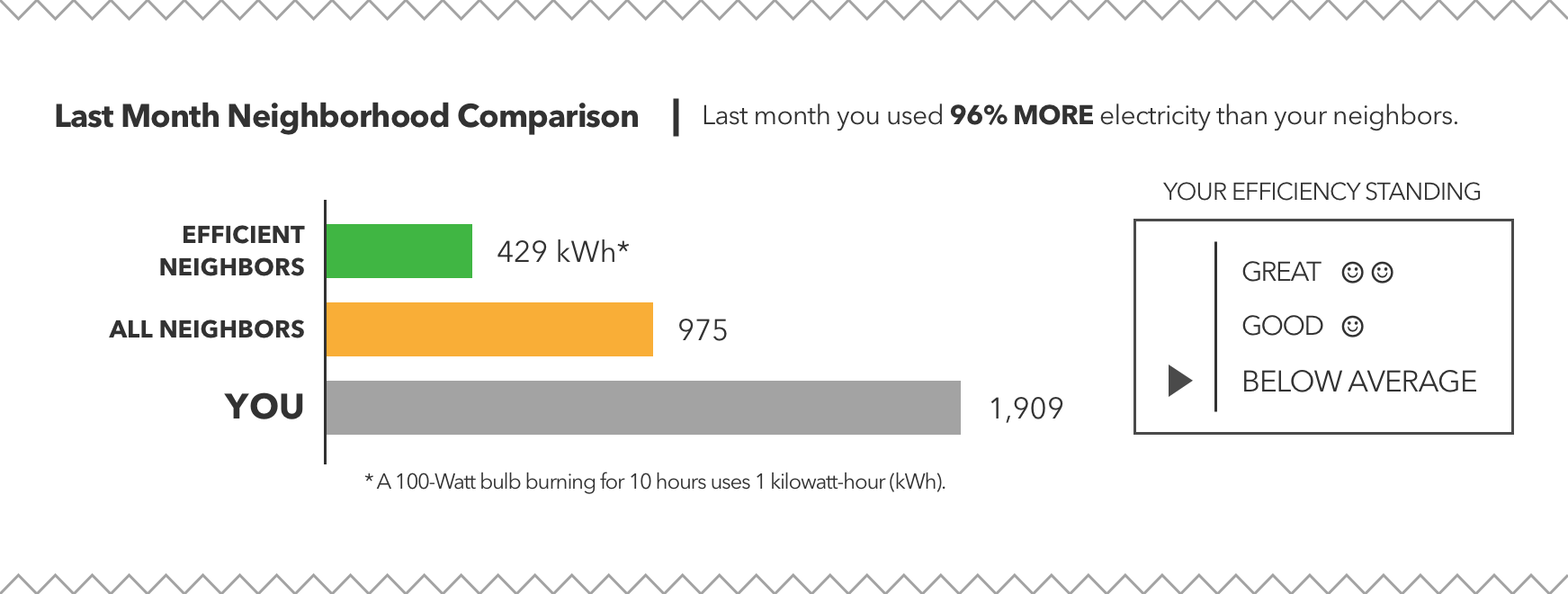
可視化功耗 (Visualizing Power Consumption)
In 2008, in an effort to reduce electricity consumption, the Sacramento Municipal Utility District tried a new technique. They sent 35,000 customers a letter with a few simple charts, showing customers their electricity consumption compared to their neighbors.
2008年,為減少電力消耗,薩克拉曼多市政公用事業區嘗試了一項新技術。 他們給了35,000個客戶一封信,并附有一些簡單的圖表,顯示了與鄰居相比客戶的用電量。
In the charts above you can see a bar graph with 3 bars, representing power consumption for 3 different groups: “efficient” neighbors, all neighbors and the recipient’s household. This showed customers if they were consuming more or less electricity than their neighbors.
在上面的圖表中,您可以看到帶有3條柱形圖的條形圖,代表3個不同組的功耗:“有效”鄰居,所有鄰居和接收者的家庭。 這向客戶顯示了他們消耗的電量是否比鄰居多。
Customers who received these letters reduced their power consumption by 2% on average (src). While this seems small in terms of an individual’s power bill, across all the customers this amounts to terawatts of electricity and millions of dollars saved collectively. Since then, other utilities around the country have adopted this approach.
收到這些信函的客戶平均將其功耗降低了2%( src )。 雖然就個人的電費而言,這似乎很小,但在所有客戶中,這總計相當于數兆瓦的電,并且集體節省了數百萬美元。 從那以后,全國其他公用事業都采用了這種方法。
超級大國: (Superpower:)
What makes these charts impactful isn’t just the feedback (“you consumed X of electricity”), it’s the context the feedback is presented in (“you consumed X, most of your neighbors consumed Y”). As people, we look to others’ behaviors as norms for our own. So by seeing others’ power consumption, people change their own consumption habits to be more consistent with the social norm.
使這些圖表具有影響力的不僅是反饋(“您消耗了X的電量”),還在于顯示了反饋的上下文(“您消耗了X的電量,大多數鄰居消耗了Y”)。 作為人,我們將他人的行為視為自己的規范。 因此,通過查看他人的用電量,人們可以改變自己的用電習慣,使其更符合社會規范。
In a related experiment, Schultz & friends found that the same message with an additional smiley or frowny face amplified the effect even further by reinforcing the behaviors of households that were already doing a good job (src).
在一項相關的實驗中,舒爾茨和朋友們發現,同一條帶有額外笑臉或皺眉的信息通過增強已經做好工作的家庭的行為進一步擴大了效果( src )。
帶走: (Takeaway:)
Nothing about the electricity usage charts are profoundly insightful, at least not in the way we might think of John Snow’s cholera maps. But even simple visualizations, when paired with an understanding of human and social psychology, can be impactful to large numbers of people. These types of visualizations won’t win a Pulitzer, but in aggregate they can make a big difference in our lives and our communities.
用電量圖表并沒有什么深刻的見識,至少在我們可能不會想到約翰·斯諾的霍亂地圖方面。 但是,即使簡單的可視化與對人類和社會心理學的理解相結合,也可能對大量人產生影響。 這些類型的可視化不會贏得普利策獎,但總的來說,它們可以對我們的生活和社區產生巨大的影響。
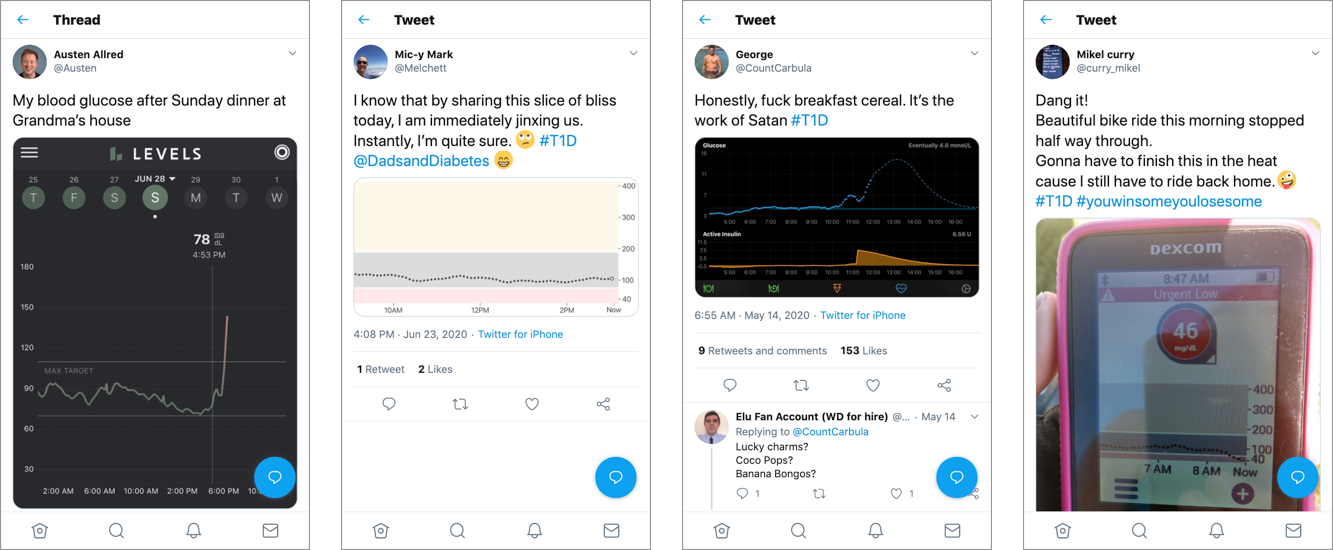
可視化血糖 (Visualizing Blood Glucose)
For the 1.6M people in the US with Type1 Diabetes, graphs like these are never far from top-of-mind. As Continuous Glucose Monitoring (CGM) becomes widespread, these charts have become part of daily life.
對于美國160萬患有1型糖尿病的人來說,像這樣的圖表從來都不是最重要的。 隨著連續血糖監測(CGM)的普及,這些圖表已成為日常生活的一部分。
Often, the plot of your blood glucose is the story of your day.
通常,您的血糖情節就是您今天的故事。
If you search Twitter for #T1D you’ll find example after example like the tweets above. What makes these so compelling is that they’re lived data. They’re a reflection of the user’s life. The value is not just the information, it’s visualization as a satisfying memento.
如果您在Twitter上搜索#T1D,則會在示例之后找到類似上述推文的示例。 是什么使得這些如此引人注目的是,他們居住的數據。 它們反映了用戶的生活。 價值不僅僅是信息,它還可以看作是令人滿意的紀念品。
Of course, these charts are also effective. In multiple studies, giving subjects with Type1 Diabetes a CGM helped improve blood sugar control significantly (src, src). For people with Type1, the CGM and these simple plots, are life-changing (and occasionally life-saving).
當然,這些圖表也是有效的。 在多項研究中,對1型糖尿病受試者進行CGM有助于顯著改善血糖控制( src , src )。 對于擁有Type1的人來說,CGM和這些簡單的圖可以改變生活(并有時可以挽救生命)。
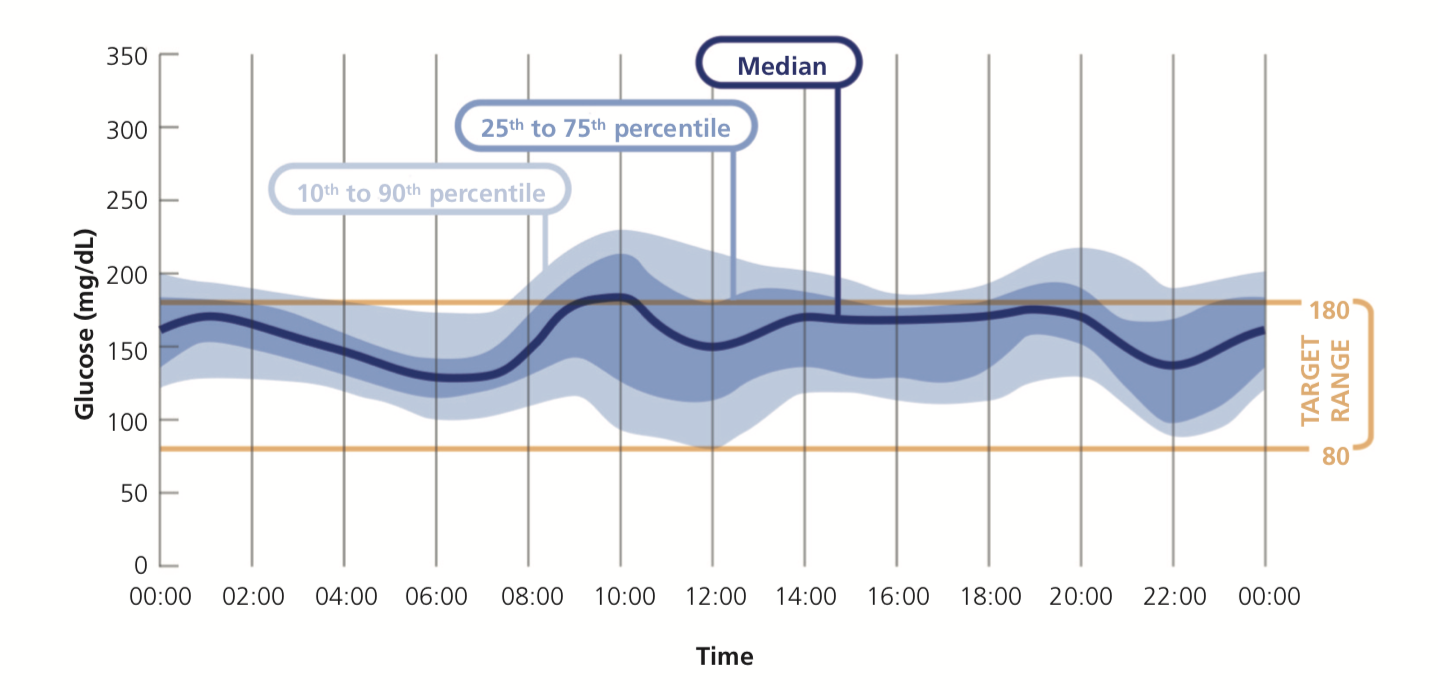
超級大國: (Superpower:)
Like Tufte and Powsner’s “Graphical Summary of Patient Status” (src), which show data in the context of a historic normal range, the chart above from Matthaei & friends presents a target range for blood glucose (because levels shouldn’t be too high or too low). This helps users quickly identify dangerous deviations, so they can take appropriate action (e.g. administering insulin).
就像Tufte和Powsner的“ 患者狀況的圖形摘要 ”( src )在歷史正常范圍內顯示數據一樣,上圖由Matthaei&friends繪制的圖表提出了血糖的目標范圍 (因為水平不應過高)或太低)。 這可以幫助用戶快速識別危險的偏差,以便他們可以采取適當的措施(例如,服用胰島素)。
While presenting goals as a range is necessary for glucose monitoring, there’s also evidence that representing any goal as a range is more effective than a point value. Targeting a range of acceptable outcomes is simultaneously more forgiving and ambitious, encouraging users to persevere over the long-term (src, src).
雖然將目標顯示為范圍對于葡萄糖監測是必要的,但也有證據表明,將任何目標表示為范圍比點值更有效。 瞄準一系列可接受的結果同時更寬容和雄心勃勃,鼓勵用戶長期堅持不懈( src , src )。
帶走: (Takeaway:)
User data is lived data. This enables visualizations that are functional and can also involve unique dimensions of nostalgia, intimacy and affirmation. Even without revealing new insights (e.g. users already know what grandma’s cooking is likely to do to their levels), there’s still value in visualization as a memento.
用戶數據是實時數據。 這使功能化的可視化成為可能,并且還可能涉及到懷舊,親密和肯定的獨特維度。 即使沒有透露新見解(例如,用戶已經知道奶奶的烹飪可能會達到他們的水平),可視化仍然是一種紀念品。

可視化屏幕時間 (Visualizing Screen-Time)

Older millennials may remember the Tamagotchi invasion of 1997. Suddenly, everyone in 6th grade had a colorful plastic ornament hanging off a belt loop or tucked in a baggy pocket. Several researchers have shown that the attachment we felt toward these digital creatures is transferable to other parts of our lives that actually deserve our vigilance.
千禧一代可能會記得1997年的“塔瑪哥奇”入侵。突然之間,六年級的每個人都有五顏六色的塑料裝飾品掛在皮帶環上或藏在寬松的口袋里。 一些研究人員表明,我們對這些數字生物的依戀可以轉移到我們生活中的其他部分,這些部分實際上值得我們保持警惕。
One challenge many of us face is limiting screen time. In 2019, Kenny Chow showed that representing screen time as an infliction on a “lively” animated avatar was a promising intervention toward reducing participants’ screen time (src). The more time users spent with devices open, the sicklier the avatar becomes.
我們許多人面臨的挑戰之一是限制屏幕時間。 在2019年,Kenny Chow展示了將屏幕時間表示為對“生動”動畫化身的侵犯,這是減少參與者屏幕時間( src )的有前途的干預措施。 用戶打開設備花費的時間越多,虛擬化身就變得越病態。
This model of creature-as-data has worked in other contexts. Lin & friends showed that representing physical activity as a virtual fish tank helped participants become more physically active (src). Consolvo and friends showed a similar effect for visualizations of flowers and butterflies standing in for exercise events and goals (src).
這種作為數據的生物模型在其他情況下也起作用。 Lin和他的朋友表明,將體育活動表現為虛擬魚缸有助于參與者提高體育活動( src )。 Consolvo和朋友對參加運動項目和目標( src )的花朵和蝴蝶的可視化顯示了相似的效果。
At first glance, these representations seem more like “data art” than “data visualization.” But I think the effect is the same. Instead of encoding data for preattentive processing via our brains’ spatial wiring, the avatars encode the data for the parts of our brains that make us social and supportive. We feel the data through our empathy for the “living” character on the screen.
乍一看,這些表示形式更像是“數據藝術”而不是“數據可視化”。 但我認為效果是一樣的。 化身不是對數據進行編碼,而是通過大腦的空間布線進行細心的處理,而是對使我們變得社交和支持的大腦各部分的數據進行編碼。 我們通過同情屏幕上的“活著”角色來感受數據。
超級大國: (Superpowers:)
This probably doesn’t make sense for a Tableau dashboard at work. For many use-cases (e.g. journalism, BI, reporting, etc), immediacy, precision and depth are supreme. For personal-viz, though, some of these constraints can be relaxed:
對于工作中的Tableau儀表板,這可能沒有任何意義。 對于許多用例(例如新聞,BI,報告等),即時性,準確性和深度都是至高無上的。 但是,對于個人而言,可以放寬一些約束:
- If you can assume the user will interact with the visualization multiple times, a longer learning curve is sometimes acceptable (and to the extent that learning the viz can instill feelings of mastery, a steeper learning curve might be desirable). 如果您可以假設用戶將與可視化進行多次交互,則有時可以接受更長的學習曲線(并且在某種程度上,學習Viz可以灌輸掌握的感覺,可能更陡峭的學習曲線是可取的)。
- Precision is sometimes undesirable (e.g. for weight loss, users can overly fixate on natural ups-and-downs). Representing data on a vague scale like “sick avatar” to “healthy avatar” can help users gain sensitivity to the metric without fixation. 有時精度是不可取的(例如,為了減輕體重,用戶可能過度偏愛自然的起伏)。 用諸如“病化身”到“健康化身”這樣的模糊表述數據可以幫助用戶無需度量即可獲得對指標的敏感性。
- If the underlying data is relatively simple and a shallower representation creates a sense of emotional attachment, forgoing depth for extended engagement is an easy tradeoff to make. 如果基礎數據相對簡單,并且較淺的表示形式產生了情感依戀感,那么放棄長期參與的深度就很容易做出權衡。
帶走: (Takeaway:)
The goals and constraints for motivational viz can be quite different from traditional dataviz, making very non-traditional visualizations like Avatars, Fish and Flowers potentially very effective. When the goal is not just conveying information, but creating an emotional connection, tapping into users’ empathy through tactics like anthropomorphization can help form an emotional bond to the underlying data.
為激勵即目標和約束可以從傳統的DataViz公司完全不同,使得像化身,魚和花卉非常非傳統的可視化可能非常有效。 當目標不僅是傳達信息,而是建立情感聯系時,通過擬人化等策略利用用戶的同理心可以幫助與基礎數據形成情感紐帶。
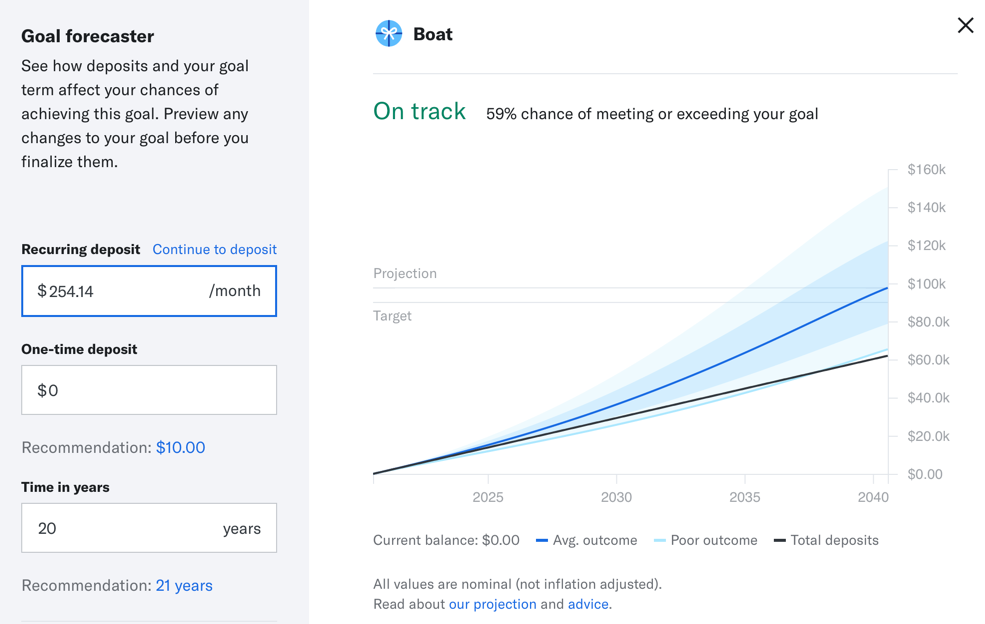
可視化財務目標 (Visualizing Financial Goals)
Most brokerage services encourage bad investing habits. From the moment users login, they see charts & graphs of their portfolio performance in the past or the market’s performance right now.
大多數經紀服務會鼓勵不良的投資習慣。 從用戶登錄的那一刻起,他們就可以查看過去或現在的市場表現的圖表。
When I spoke with Dan Egan (Head of Behavioral Finance at Betterment), he said this backward-looking focus leads users to reactionary decision making, ultimately hurting their long-term financial outcomes (e.g. “Oh! The market just went down, I have to sell out because I don’t want it to go down more”).
當我與丹尼爾·埃根(Betterment行為金融學負責人)交談時,他說,這種向后看的重點使用戶做出了反動的決策,最終損害了他們的長期財務成果(例如,“哦!市場剛剛下跌,我有賣光了,因為我不想讓它下跌更多”。
Egan’s research suggests that the more users fixate on portfolio performance, the more likely they are to fidget, and fidgeting lowers users’ expected returns (src).
埃根(Egan)的研究表明,用戶對投資組合績效的關注程度越高,他們越容易坐立不安,而坐立不安會降低用戶的預期收益( src )。
According to Dan: “In investing, people spend a lot of time looking at history. But you just can’t change history. You can’t change that outcome.” Instead, “the only thing that matters is what you decide to do with today and how that sets you up for the future.”
丹說:“在投資中,人們花很多時間看歷史。 但您只是無法更改歷史記錄。 您無法改變結果。” 取而代之的是,“唯一重要的是您決定今天如何做以及如何為將來做準備。”
So Betterment encourages users to look forward by offering visualizations like the Goal Forecaster, designed to “focus you on the future and where you want to end up.” It helps you see “how your actions today put you in a better position in the future.”
因此,Betterment通過提供諸如“目標預測器”之類的可視化工具來鼓勵用戶前瞻 ,這些可視化工具旨在“使您著眼于未來以及最終目標。” 它可以幫助您了解“您今天的行為如何使您將來處于更好的位置。”
Research backs this up. Simulating various saving schedules helps users connect the cause and effect of their actions now (auto-deposit) with likely future outcomes (boat). Making these relationships concrete helps people grasp the effects of complex concepts like exponential growth and motivates users to save more (src, src). Another 2015 study suggests that highlighting the difference between savings goals and savings projections helps participants make better decisions, using the endowment effect to their advantage (src).
研究對此提供了支持。 模擬各種保存計劃可以幫助用戶將其行動的因果關系(自動存款)與可能的未來結果(船)聯系起來。 使這些關系具體化可以幫助人們掌握復雜概念(如指數增長)的影響,并激勵用戶節省更多( src , src )。 2015年的另一項研究表明,強調儲蓄目標與儲蓄預測之間的差異有助于參與者利用the 賦效應發揮其優勢( src ),從而做出更好的決策。
Finally, the Goal Forecaster helps set realistic expectations. Realistic expectations about future goals make us more likely to achieve them (src). Presenting the projected savings in a fan-chart helps reinforce the message that there’s uncertainty in any financial journey, while still conveying the benefits of investing over the long term.
最后,目標預測器可幫助設定切合實際的期望。 對未來目標的現實期望使我們更有可能實現這些目標( src )。 在扇形圖中顯示預計的節省額有助于進一步增強信息,即任何財務旅程都存在不確定性,同時仍可以傳達長期投資的好處。
超級大國: (Superpower:)
Dan says, consider “showing not telling: “If you let people simulate their outcomes — if you let them experience parallel universes — that is more effective in getting them to understand what’s going to happen than if you describe it. Allowing people to really experience it and see the variations allows them to internalize it as real.”
丹說,請考慮“不要說: ”如果讓人們模擬他們的結果-如果讓他們體驗平行的宇宙-相對于描述它,它更能使他們了解即將發生的事情。 讓人們真正體驗它并看到其變化,就可以將其內部化為真實。”
帶走: (Takeaway:)
For Betterment, letting users look ahead is informational and motivational. Simulating short term actions playing out over the long term helps educate users about difficult-to-imagine cause and effect relationships, giving them the confidence to make smarter choices. Having realistic expectations about the future helps users prepare themselves for a long journey.
為了改善,讓用戶放眼未來是信息和激勵。 模擬長期的短期行為可以幫助用戶了解難以想象的因果關系,使他們有信心做出更明智的選擇。 對未來抱有切合實際的期望,可以幫助用戶為漫長的旅途做好準備。
可視化健身活動 (Visualizing Fitness Activity)
Tracking physical activity helps many people stay active (src). The challenge is maintaining users’ attention and getting them to stick with the intervention. In this context, visualization can be a tool for both conveying data and rewarding users for collecting the data in the first place.
跟蹤身體活動有助于許多人保持活躍( src )。 挑戰在于保持用戶的注意力并使他們堅持干預。 在這種情況下,可視化可以既是傳達數據又是獎勵用戶收集數據的工具。
顎骨向上 (Jawbone UP)
Jawbone’s UP app (circa ~2012) was one of my favorite examples of this. In the screenshots above, there are two bar charts of users’ step counts. For most of the day, you’re seeing a chart like the left, but by the end of the day, once you’ve crossed your goal threshold (e.g. 10,000 steps), the background explodes into a happy sunburst, helping you celebrate the accomplishment!
Jawbone的UP應用程序(大約2012年)是我最喜歡的示例之一。 在上面的屏幕截圖中,有兩個用戶步數的條形圖。 在一天的大部分時間里,您會看到如左圖所示的圖表,但是到一天結束時,一旦您越過了目標閾值(例如10,000步),背景就會爆炸成快樂的朝陽狀態,從而幫助您慶祝成就!
With wanton disregard for data-ink ratios, Jawbone’s designers were masters at conjuring up visual joy. The effect was users who felt supported and encouraged to keep hitting their goals (and, implicitly, to continue tracking and interacting with the data).
Jawbone的設計師無視數據墨水比率,因此他們在喚起視覺愉悅方面是大師。 結果是用戶感到支持并鼓勵他們繼續實現他們的目標(并隱式地繼續跟蹤數據并與之交互)。
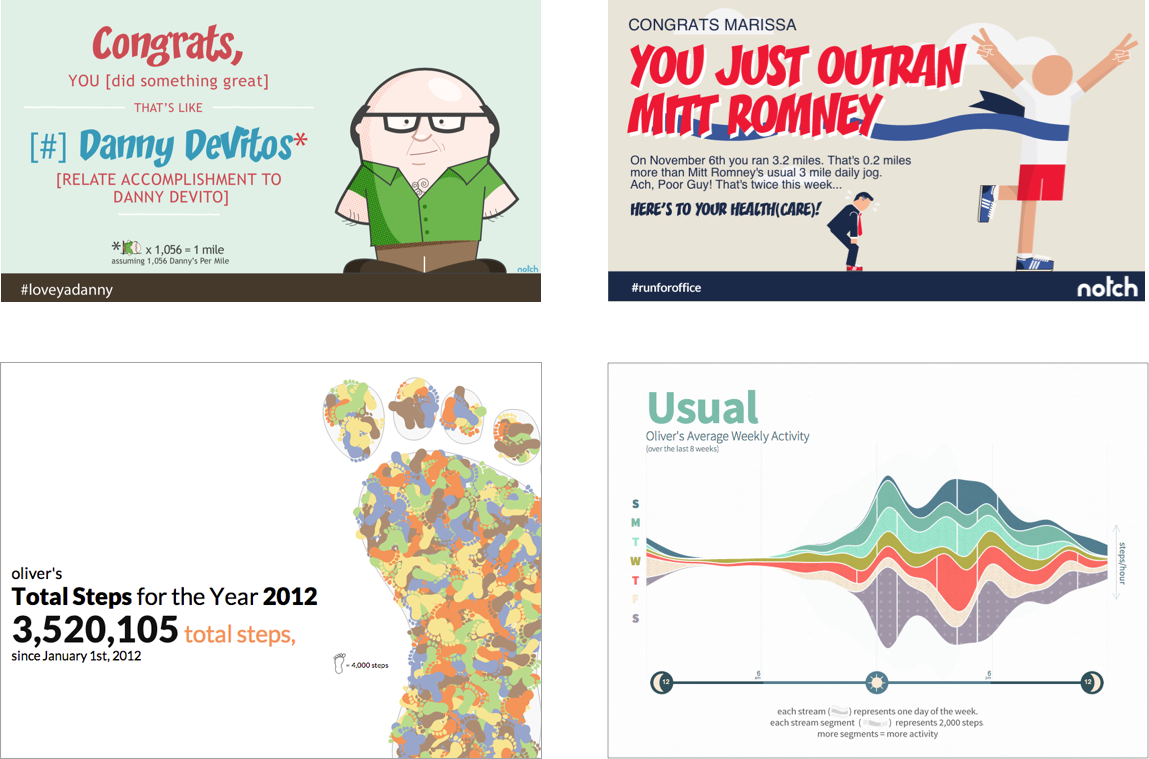
Notch.me (Notch.me)
With Notch.me, we did similar work using emailed “postcard visualizations” to heighten user’s sense of accomplishment at various milestones (and create a sense of anticipation for future milestones). The data was sourced from user’s personal activity tracking (e.g. via Fitbit) and presented back to users in various encouraging visualizations like the ones above.
使用Notch.me,我們使用電子郵件發送的“明信片可視化”來完成類似的工作,以增強用戶在各個里程碑的成就感(并為將來的里程碑創建一種期待感)。 數據來自用戶的個人活動跟蹤(例如,通過Fitbit),并通過各種令人鼓舞的可視化形式(如上圖所示)呈現給用戶。
The two top postcards above, use visual metaphor to compare a user’s activity to something unexpected and silly; they’re extremely low data-density, but still quite effective in directing recipients’ attention toward their data.
上方的兩張最上面的明信片使用視覺隱喻將用戶的活動與意外和愚蠢的事物進行比較; 它們的數據密度極低,但在將收件人的注意力引向其數據方面仍然非常有效。
The two bottom postcards show users’ activity for a set time period (left: 1 year, right: 1 week); this encouraged users to track more consistently during those periods in anticipation of a more elaborate, pleasant visualization (the more you track, the cooler it looks).
底部的兩個明信片顯示了用戶在設定時間段內的活動(左:1年,右:1周); 這鼓勵用戶在那些時期內更一致地進行跟蹤,以期獲得更加精致,令人愉悅的可視化效果(跟蹤的次數越多,外觀越酷)。
In various experiments, visualizations like the above captured user attention and boosted engagement with the data. And, as you might expect from “sugary,” chart-junky visualizations, users loved them.
在各種實驗中,像上面這樣的可視化吸引了用戶的注意并增強了對數據的參與。 而且,正如您可能從“雜亂無章”的圖表式可視化中期望的那樣,用戶喜歡它們。
超級大國: (Superpowers:)
Remember Nigel Holmes and the power of humor (src): “My feeling then, and now, is that humor is a good way to get people’s attention. Get a reader to smile or recognize a visual reference and they’ll surely read on.”
記得奈杰爾·福爾摩斯(Nigel Holmes)和幽默的力量( src ):“我當時和現在的感覺是,幽默是引起人們關注的好方法。 讓讀者微笑或識別視覺參考,他們一定會繼續閱讀。”
In addition to capturing attention, Holmes’ style of visualization has also been shown to increase the memorability of the content (src). Perhaps an overlooked aspect of Holmesian visualizations is that they feel good. This is powerful in its own way: Positive feedback and positive affect (emotion) is important for helping people make positive changes.
除了吸引注意力之外,霍姆斯的可視化樣式還被證明可以增加內容( src )的可記憶性。 Holmesian可視化的一個可能被忽視的方面是它們感覺良好。 這有其自身的強大功能:積極的反饋和積極的情感(情感)對于幫助人們做出積極的改變很重要。
帶走: (Takeaway:)
For information to make a difference, it has to be seen. Humor, visual metaphor and even pleasant visual flourishes not only serve to draw users’ attention, but they’re also emotionally and viscerally rewarding methods to reinforce engagement with the data. For Jawbone’s visual flourishes and, pretty much everything with Notch.me, the goal for each visualization was as much about information as it was affirmation.
為了使信息有所作為,必須看到它。 幽默,視覺隱喻甚至愉悅的視覺效果不僅可以吸引用戶的注意力,而且在情感上和內在上都是獎勵與數據互動的方法。 對于Jawbone的視覺蓬勃發展以及Notch.me的幾乎所有內容而言,每種可視化的目的都與信息有關,而與信息有關。

可視化閱讀活動 (Visualizing Reading Activities)
Kindle’s “Reading Insights” is a relatively new addition to the Kindle iOS / Android apps. I think there’s a lot to praise with this. Reading is another of life’s many activities that, despite wanting to do more of it, we struggle to make it happen as often as we’d like. So offering users a way to track and reflect on their reading could see a meaningful increase in time spent reading.
Kindle的“ Reading Insights”是Kindle iOS / Android應用程序的一個相對較新的功能。 我認為這值得贊揚。 閱讀是生活中許多活動中的另一項,盡管它想做更多事情,但我們努力使它盡可能多地發生。 因此,為用戶提供一種跟蹤和反思其閱讀方式的方法可能會導致閱讀時間的顯著增加。
I think it’s also emotionally satisfying. In the same way, a physical bookshelf is like a trophy case for nerds, seeing the books you’ve read front and center feels good. Like stickers, it’s a visual representation of your accomplishments that you can feel proud of.
我認為這在情感上也令人滿意。 同樣,實體書架就像書呆子的獎杯盒一樣,看到您在書架正面和中央閱讀的書感覺很好。 就像貼紙一樣,它是成就感的直觀體現,令人感到驕傲。
The downside, and this is true of many similar visualizations, is it gives Amazon a justification for even further surveillance (src). This serves as an important reminder that, with this new frontier of data there are ways that it can be legitimately useful to end-users, but that’s not without tradeoffs. As makers and designers, we should keep the ethics of personal data use top of mind. (As a silver lining, thanks to CCPA, you can now request all of Amazon’s data on your reading habits to visualize for yourself!)
不利的一面(在許多類似的可視化中都是如此)是,它為亞馬遜提供了進行進一步監視( src )的理由。 這是一個重要的提醒,在這種新的數據領域中,有一些方法可以對最終用戶合法有用,但這并非沒有取舍。 作為制造商和設計師,我們應該牢記個人數據使用的道德規范。 (作為一線希望,多虧了CCPA ,您現在可以根據自己的閱讀習慣要求獲取Amazon的所有數據,以便自己查看!)
帶走: (Takeaway:)
Visualizing user data creates exciting opportunities for both users and designers, but it also brings new responsibilities. For every thoughtful blood-glucose visualization attempting to empower users, there’s an Uber out there using behavioral data to manipulate. As we rightly question the role of data and algorithms in a just world, we shouldn’t forget that visualizations, like any non-neutral technology, can be used for harm and for good.
可視化用戶數據為用戶和設計人員都帶來了令人興奮的機遇,但同時也帶來了新的責任。 對于每一次試圖增強用戶可視化的血糖可視化嘗試,都有一個Uber 使用行為數據進行操作 。 當我們正確地質疑數據和算法在公正世界中的作用時,我們不應忘記,可視化像任何非中立技術一樣,可以帶來傷害和好處。
外賣 (Takeaways)
Epic, John Snow-eque, Pulitzer-worthy dataviz is amazing, but dataviz can also be impactful in everyday use. This seems worth celebrating.
史詩般的約翰·斯諾克(Epic),普利策(Pulitzer)值得一看的dataviz 令人驚嘆,但是dataviz在日常使用中也會產生影響。 這似乎值得慶祝。
- Instead of revealing the secrets of the universe, motivational visualization is about offering lenses on a subject that users are already intimately familiar with: themselves. 動機可視化不是揭示宇宙的秘密,而是提供用戶已經非常熟悉的主題鏡頭:自己。
- While the medium is the same, design goals for “motivational visualization” differ from traditional dataviz. Instead of singular dedication to information gain and/or impacting big decisions, user-data visualizations tend to benefit everyday behaviors and micro-decisions. 盡管媒介是相同的,但“動機可視化”的設計目標卻不同于傳統的數據可視化。 用戶數據可視化不是單單致力于獲取信息和/或影響重大決策,而是傾向于使日常行為和微觀決策受益。
- Motivational viz can help in a variety of ways (e.g. encouraging adoption of social initiatives, managing health conditions, helping people persevere toward long-term goals or developing new habits, etc). As the field evolves we should keep our eyes peeled for emerging tactics and new opportunities to apply them (while keeping vigilant against anti-patterns and dark-patterns that may emerge as well). 動機性視覺可以多種方式提供幫助(例如,鼓勵采取社會措施,管理健康狀況,幫助人們堅持長期目標或養成新習慣等)。 隨著領域的發展,我們應該對新興的策略和應用這些策略的新機會保持警惕(同時還要警惕可能出現的反模式和暗模式)。
If you’re a dashboard designer, product designer or anyone else helping visualize user data, you’ve got superpowers to inform and inspire.
如果您是儀表板設計師,產品設計師或任何其他幫助可視化用戶數據的人員,那么您將擁有超能力來提供信息和啟發。

You can follow the TLDR thread here on Twitter!
您可以在Twitter上關注TLDR線程!

Who am I? No, no, who are you?!
我是誰? 不,不,你是誰?
Hi! I’m Eli Holder. I help clients use data to create positive change by engaging audiences not just rationally, but also emotionally and culturally. Change happens in the head and the heart.
嗨! 我是Eli Holder。 我幫助客戶不僅通過理性地而且在情感上和文化上吸引受眾,從而利用數據創造積極的變化。 變化發生在頭部和心臟。
If you’re a founder, maker, storyteller or business leader working at the intersection of data, design and user psychology, I’d love to connect and trade stories.
如果您是在數據,設計和用戶心理的交匯處工作的創始人,制造商,講故事者或業務負責人,那么我很想聯系和交易故事。
You can email me at hi@elih.co or follow me on Twitter.
您可以通過hi@elih.co給我發送電子郵件,或者在Twitter上關注我。

翻譯自: https://medium.com/nightingale/visualizing-users-impacts-superpowers-14c6b5698c0a
數據可視化 信息可視化
本文來自互聯網用戶投稿,該文觀點僅代表作者本人,不代表本站立場。本站僅提供信息存儲空間服務,不擁有所有權,不承擔相關法律責任。 如若轉載,請注明出處:http://www.pswp.cn/news/387950.shtml 繁體地址,請注明出處:http://hk.pswp.cn/news/387950.shtml 英文地址,請注明出處:http://en.pswp.cn/news/387950.shtml
如若內容造成侵權/違法違規/事實不符,請聯系多彩編程網進行投訴反饋email:809451989@qq.com,一經查實,立即刪除!








)









